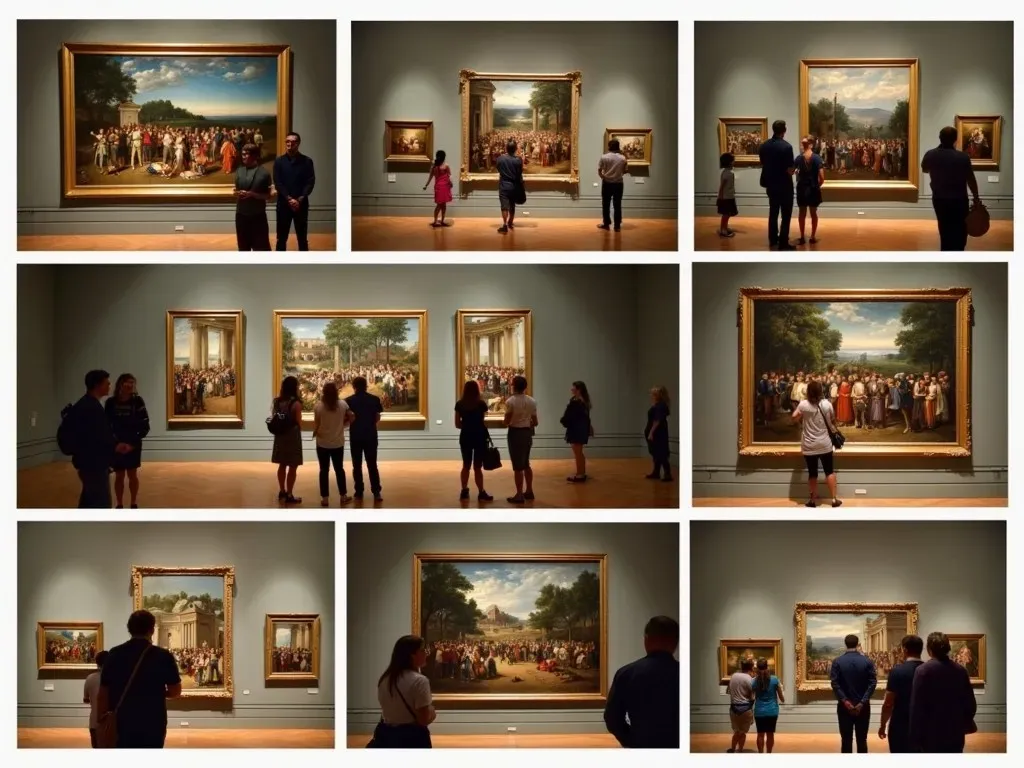The Metropolitan Museum of Art (often referred to as the Met Museum) is renowned for its extensive collection of over two million objects, including countless famous paintings. Situated in New York City, the Met is the largest art museum in the United States and a pivotal point of interest for art lovers across the globe. Among its treasures lie many pieces that are not just masterpieces but pivotal in defining art history.
The Met’s Most Iconic Paintings
When it comes to Famous Paintings at the Met, the museum dazzles with an array of artworks from diverse artists and eras. Here’s a curated list of some of the most talked-about paintings you should definitely explore:
| Painting Title | Artist | Year | Location in the Met |
|---|---|---|---|
| Washington Crossing the Delaware | Emanuel Leutze | 1851 | American Wing |
| The Death of Socrates | Jacques-Louis David | 1787 | European Painting Galleries |
| The Horse Fair | Rosa Bonheur | 1853 | American Wing |
| Venus and the Lute Player | Titian | 1570 | European Painting Galleries |
| Julie Le Brun Looking in a Mirror | Elisabeth Louise Vigée Le Brun | 1787 | European Painting Galleries |
| Self-Portrait with a Straw Hat | Édouard Manet | 1880 | European Painting Galleries |
The Top Ten Must-See Masterpieces
-
Washington Crossing the Delaware
This monumental painting captures a pivotal moment in American history. Leutze’s work operates on both artistic and historical levels, symbolizing hope and courage during the Revolutionary War. -
The Death of Socrates
This neoclassical painting represents the moment before Socrates’ demise, epitomizing philosophical virtues and moral courage. -
The Horse Fair
Rosa Bonheur’s lifelike depiction of horses is both a technical and emotional masterpiece, representing her passion for animals and skill in capturing movement. -
Venus and the Lute Player
Titian’s sensual portrayal highlights the connection between art and music, embodying the spirit of the Renaissance. -
Julie Le Brun Looking in a Mirror
This thrilling self-portrait by Vigée Le Brun showcases not only her talent but also the agency of women in art during the 18th century. -
Self-Portrait with a Straw Hat
Manet’s candid approach to self-portraiture heralds modernism, breaking away from traditional depiction.
The Met is not only a gallery filled with stunning images but also a canvas on which the stories of art and culture unfold. Each painting stands as a testament to the era it represents, revealing the evolution of artistic forms and themes.
Notable Features of the Met’s Collection
- The museum’s collection spans over 5,000 years of art, covering a broad range of styles, periods, and geographic regions.
- It presents an extensive array of pieces from European Masters to Modern Art, creating a visual timeline of artistic expression.
Interesting Facts About The Met’s Paintings
- The Met hosts an annual attendance of over 7 million visitors, making it one of the most visited museums worldwide.
- The Met’s European Paintings collection contains works from renowned artists such as Van Gogh, Vermeer, and Monet.
How to Experience the Met
Visiting the Met Museum can be an overwhelming experience due to its vast size and variety. Here are tips to enhance your visit:
- Plan Ahead: Check out the museum’s website for current exhibitions and special events.
- Guided Tours: Take a guided tour to learn about the context and history behind the artworks. Tours can offer deeper insights into highlighted pieces, enhancing your understanding and appreciation of famous art at the Met.
- Audio Guides: These can be rented or downloaded for self-guided tours. Audio guides often give detailed commentary on specific paintings.
Thematic Areas of Interest
- Renaissance Art: The Met houses masterpieces from the Italian Renaissance, including works by da Vinci and Raphael.
- American Art: Highlighting the spectrum of American artistic expression, the American Wing showcases works from the colonial period to the early 20th century.
- Modern and Contemporary Art: Comprising various movements and styles, the Met’s modern collection invites ongoing dialogue about art’s relevance today.
Frequently Asked Questions (FAQs)
What is the most famous painting in the Met?
The Met’s most renowned piece is often considered to be Washington Crossing the Delaware, due to its historical significance and dramatic composition.
How much time should I spend at the Met?
Most visitors suggest spending at least three to four hours. However, art enthusiasts may find themselves captivated for an entire day or more.
Is there an admission fee?
The Met operates on a suggested admission model for New York State residents and students from New Jersey and Connecticut; other visitors should check the website for specific fees.
Can I take photographs in the museum?
Photography without flash is generally permitted in the galleries, but some exhibitions may have restrictions. It’s essential to check for any signs posted.
Where can I find more information about the artworks?
The Met’s official website offers extensive resources, including detailed descriptions and high-resolution images of their entire collection. For more details, check Metropolitan Museum of Art Official Site.
Immerse yourself in the transcendental world of art at the Metropolitan Museum of Art. With each step through its galleries, you’ll find a new story, a brushstroke from the past, narrating the evolution of humanity through the eye of the artist. The Met Museum is more than a collection; it’s a celebration of creativity, culture, and contemplation.
